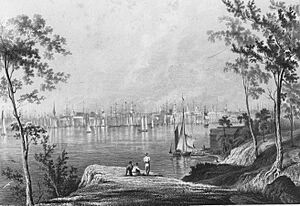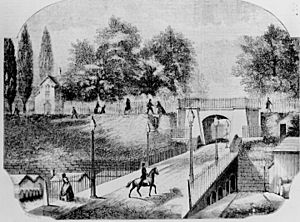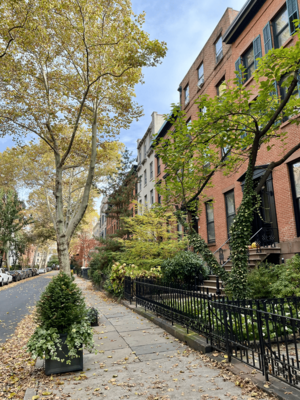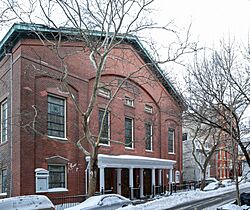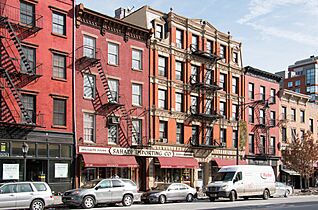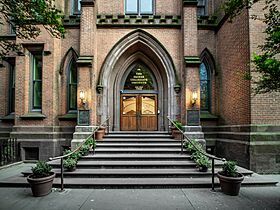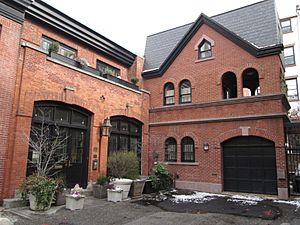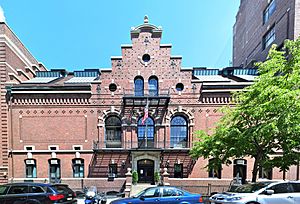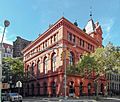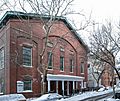Brooklyn Heights facts for kids
Quick facts for kids
Brooklyn Heights
|
|
|---|---|
|
Neighborhood of Brooklyn
|
|

Townhouses in Brooklyn Heights
|
|
| Country | |
| State | |
| City | New York City |
| Borough | Brooklyn |
| Community District | Brooklyn 2 |
| Area | |
| • Total | 0.320 sq mi (0.83 km2) |
| Population
(2020)
|
|
| • Total | 25,092 |
| • Density | 78,410/sq mi (30,280/km2) |
| Ethnicity | |
| • White | 75.2% |
| • Asian | 8.8% |
| • Hispanic | 7.3% |
| • Black | 5.5% |
| • Others | 3.1% |
| Economics | |
| • Median income | $119,999 |
| Time zone | UTC−04:00 (Eastern) |
| • Summer (DST) | EDT |
| ZIP Codes |
11201
|
| Area code | 718, 347, 929, and 917 |
Brooklyn Heights is a historic and beautiful residential neighborhood in the New York City borough of Brooklyn. It's known for its charming streets and many old brownstone homes. The neighborhood is located near the Brooklyn Bridge to the north and Atlantic Avenue to the south. To its east is Downtown Brooklyn, and to the west is the East River.
Brooklyn Heights has been an important part of Brooklyn since 1834. Many of its unique rowhouses were built before the American Civil War. It's also home to many famous churches and religious buildings. In 1965, a large part of Brooklyn Heights became the Brooklyn Heights Historic District. This was the first historic district in New York City, created to protect its special buildings.
The neighborhood is right across the East River from Manhattan. You can easily get there by subway or ferry. Brooklyn Heights is part of Brooklyn Community District 2. Its main ZIP Code is 11201.
Contents
- Discovering Brooklyn Heights' Past
- Amazing Architecture and Landmarks
- Community Life and Demographics
- Fire Safety and Services
- Post Offices and ZIP Code
- Education Opportunities
- Getting Around Brooklyn Heights
- Famous Street Names
- Famous People from Brooklyn Heights
- Brooklyn Heights in Movies and TV
- Images for kids
- See also
Discovering Brooklyn Heights' Past
Early Days and Important Events
Brooklyn Heights sits on a high bluff that rises from the East River. Long ago, the native Lenape people called this area "Ihpetonga," meaning "the high sandy bank."
Ferries started crossing the East River as early as 1642. These ferries helped the area grow, especially the lowlands near the water. The higher ground was not used as much at first.
During the American Revolutionary War, the area was heavily fortified. After a tough battle, General George Washington cleverly moved his troops from here across the East River to Manhattan. He managed to save all his soldiers and supplies.
How Brooklyn Heights Grew
Brooklyn Heights really started to grow after 1814. That's when Robert Fulton began regular steam ferry service. A major landowner named Hezekiah Beers Pierrepont helped make this happen. He owned a lot of land and wanted to sell it to wealthy people from Manhattan. Easy ferry access made this possible.
In 1816, Brooklyn became an official village. This led to streets being laid out in a grid pattern. Sidewalks were added, and water pumps were installed. By 1823, farms were divided into smaller lots. These were advertised as perfect "country retreats" for people living in Manhattan.
This led to a building boom, making Brooklyn Heights the first "commuter suburb." It was faster to get to Manhattan by ferry from here than from upper Manhattan by land. By 1860, there were over 600 houses in the Heights. By 1890, most of the area was fully developed.
Throughout the 1800s, Brooklyn Heights remained a very elegant neighborhood. It became the cultural and financial center of Brooklyn.
Before the American Civil War, Brooklyn Heights was a key spot for the Abolitionist movement. This was largely due to Henry Ward Beecher, the pastor of Plymouth Church. Beecher was famous for his speeches against slavery. So many enslaved people passed through Plymouth Church on their way to freedom that it was called the "Grand Central Station of the Underground Railroad."
Changes in the 20th Century
The Brooklyn Bridge opened in 1883, making the neighborhood easier to reach. In 1908, the subway arrived, which also helped. However, this made the area less exclusive. Many wealthy families moved out, and their large homes were divided into apartments. Artists and writers began to move in.
During the 1940s and 1950s, the building of the Brooklyn-Queens Expressway (BQE) changed the neighborhood. It took away some of the northwest part of Brooklyn Heights. At first, there were plans to replace many of the old brownstone homes with large apartment buildings.
However, community groups like the Brooklyn Heights Association worked to protect the neighborhood. They helped create the Brooklyn Heights Promenade. This beautiful walkway was built over the BQE. It offers amazing views of the Statue of Liberty, the Manhattan skyline, and the Brooklyn Bridge.
By the mid-1950s, new homeowners started to buy and fix up the old houses. This led to the "Brownstone Revival" and the preservationist movement. In 1965, Brooklyn Heights became the first historic district in New York City. This helped keep the neighborhood's unique look and feel.
Brooklyn Heights Today
Starting in 2008, Brooklyn Bridge Park was built along the East River shoreline. This park is now almost complete and offers beautiful green spaces and activities. A new bridge, the Squibb Park Bridge, opened in 2020, connecting the park to Brooklyn Heights. In recent years, more and more famous people have chosen to live in this charming neighborhood.
Amazing Architecture and Landmarks
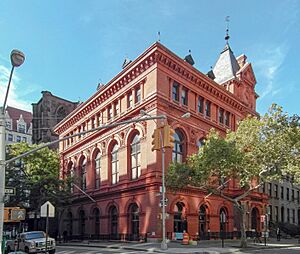
Brooklyn Heights was the first neighborhood in New York City to be protected by a special law in 1965. This means its unique buildings are preserved. The neighborhood is mostly made up of beautiful rowhouses and some large mansions. You can see many different architectural styles here, like Greek Revival, Italianate, and Victorian Gothic.
Many houses are made of reddish-brown stone called "brownstone." A typical brownstone rowhouse is three or four stories tall. The main entrance is usually above street level, reached by stairs called a "stoop." The back of the house often has a private garden.
Brooklyn Heights has over 600 houses built before the Civil War. This is one of the largest collections of such homes in the country. The buildings are usually three, four, or five stories tall, which gives the neighborhood a friendly, human-scale feeling.
There are very few tall buildings in Brooklyn Heights. Some exceptions include 75 Livingston Street and the Hotel St. George. The Jehovah's Witnesses once had their world headquarters here, restoring many historic buildings.
The former offices of the Brooklyn Dodgers baseball team were also in Brooklyn Heights. A plaque at 215 Montague Street marks the spot where Jackie Robinson signed his famous baseball contract.
Many important buildings are located here, such as Plymouth Church of the Pilgrims and Our Lady of Lebanon Maronite Catholic Cathedral. Other notable places include the First Unitarian Congregational Society, the Center for Brooklyn History (formerly the Long Island Historical Society), and Packer Collegiate Institute. Montague Street also has several historic bank buildings.
-
Plymouth Church (1849)
Community Life and Demographics
Brooklyn Heights is a vibrant community. In 2020, its population was 25,092 people. The neighborhood is mostly White (75.2%), with significant Asian (8.8%), Hispanic (7.3%), and Black (5.5%) populations.
The median household income in Brooklyn Heights is quite high, around $119,999. This means it's a well-off area compared to many other parts of New York City. Most adults in Brooklyn Heights have a college education or higher.
Fire Safety and Services
The New York City Fire Department (FDNY) helps keep Brooklyn Heights safe. There are two fire stations located in or very close to the neighborhood. Engine Company 205/Ladder Company 118 is at 74 Middagh Street, and Engine Company 224 is at 274 Hicks Street.
Post Offices and ZIP Code
Brooklyn Heights uses the ZIP Code 11201. The United States Post Office has two locations nearby: the Cadman Plaza Station and the DUMBO Automated Postal Center.
Education Opportunities
Brooklyn Heights offers excellent educational opportunities. Many residents have a college degree. Students in Brooklyn Heights and nearby Fort Greene often do very well in math and reading.
Schools in the Neighborhood
- St. Ann's School: A school for students from kindergarten to 12th grade.
- Packer Collegiate Institute: Another K-12 school, founded in 1845.
- St. Francis College: A college founded in 1859. It's known for being one of the most diverse colleges in the United States.
- Brooklyn Law School: A law school founded in 1901.
Local Libraries
The Brooklyn Public Library (BPL) has a branch in Brooklyn Heights. The current branch is at 286 Cadman Plaza West. The old library building was sold and replaced with a new building that includes a smaller, modern library at its base.
Getting Around Brooklyn Heights
Brooklyn Heights is easy to get to and from, thanks to its many transportation options.
Subway Access
Several subway lines serve Brooklyn Heights:
- The A and C train at High Street.
- The A, C, F <F>, N, R, and W trains at Jay Street–MetroTech.
- The 2 and 3 train at Clark Street.
- The 2, 3, 4, 5, N, R, and W train at Borough Hall/Court Street.
Bus and Ferry Services
While no bus routes stop directly in Brooklyn Heights, many MTA Regional Bus Operations bus routes are nearby in Downtown Brooklyn. The B25 stops in Dumbo/Fulton Ferry, and the B61, B63 serve Cobble Hill.
Since 2017, the NYC Ferry's South Brooklyn route also stops at Brooklyn Bridge Park Piers 1 and 6 in Brooklyn Heights. This offers a fun way to travel by water.
Famous Street Names
Many streets in Brooklyn Heights are named after important people who shaped the neighborhood's history.
- Adams Street – Named after John Adams, the second President of the United States.
- Clinton Street – Named after DeWitt Clinton, a former mayor of New York City and governor of New York state.
- Fulton Street, Old Fulton Street – Named after Robert Fulton, who started the steam ferry service.
- Henry Street – Named after Dr. Thomas Henry, a medical society president.
- Hicks Street – Named after John and Jacob Hicks, early ferry operators.
- Joralemon Street – Named after Teunis Joralemon, a saddle maker.
- Livingston Street – Named after Philip Livingston, who signed the United States Declaration of Independence.
- Middagh Street – Named after the Middaghs, a family from before the Revolutionary War.
- Monroe Place – Named after James Monroe, the fifth President of the United States.
- Montague Street – Named after Lady Mary Wortley Montagu, a cousin of the Pierrepont family, known for her work on smallpox prevention.
- Pierrepont Street, Pierrepont Place – Named after Hezekiah Pierrepont, often called the "founder" of Brooklyn Heights.
- Remsen Street – Named after Henry Remsen, whose family was important in the 17th century.
You might notice some "fruit streets" like Cranberry, Orange, and Pineapple Streets. Legend says these names came from a member of the Middagh family who disliked the original family names and secretly changed the street signs! The city eventually made her new names official. Love Lane is said to be named after a spot where young lovers used to meet.
Famous People from Brooklyn Heights
Many well-known people have lived in Brooklyn Heights over the years. Here are just a few:
- W. H. Auden (1907–1973), a famous poet.
- Tyra Banks (born 1973), a television personality and model.
- Javier Bardem (born 1969), an actor.
- Henry Ward Beecher (1813–1887), a clergyman and abolitionist.
- Björk (born 1965), a musician.
- Emily Blunt (born 1983), an actress.
- Matthew Broderick (born 1962), an actor.
- Truman Capote (1924–1984), a well-known author.
- Jennifer Connelly (born 1970), an actress.
- Penélope Cruz (born 1974), an actress.
- Matt Damon (born 1970), an actor.
- Pete Davidson (born 1993), a comedian.
- Adam Driver (born 1983), an actor known for Star Wars.
- W. E. B. Du Bois (1868–1963), a sociologist and civil rights activist.
- Lena Dunham (born 1986), an actress, writer, and director.
- Paul Giamatti (born 1967), an actor.
- John Krasinski (born 1979), an actor.
- Kendrick Lamar (born 1987), a rapper and songwriter.
- H. P. Lovecraft (1890–1937), a short-story writer.
- Norman Mailer (1923–2007), a novelist.
- Carson McCullers (1917–1967), a writer.
- Arthur Miller (1915–2005), a famous playwright.
- Henry Miller (1891–1980), an author.
- Mary Tyler Moore (1936–2017), an actress.
- Gary Oldman (born 1958), an actor.
- Sarah Jessica Parker (born 1965), an actress.
- Hezekiah Pierrepont (1768–1838), a key figure in developing the neighborhood.
- Robert Redford (born 1936), an actor and director.
- John A. Roebling (1806–1869), the designer of the Brooklyn Bridge.
- Washington Roebling (1837–1926), who helped build the Brooklyn Bridge.
- Keri Russell (born 1976), an actress.
- Amy Schumer (born 1981), a comedian and actress.
- Ed Sheeran (born 1991), a singer-songwriter.
- Alexander Skarsgard (born 1976), an actor.
- Dan Stevens (born 1982), an actor.
- Walt Whitman (1819–1892), a famous poet.
- Michelle Williams (born 1980), an actress.
- Thomas Wolfe (1900–1938), a novelist.
- Adam Yauch (1964–2012), a founding member of the Beastie Boys.
Brooklyn Heights in Movies and TV
Brooklyn Heights has been a popular setting for many movies and TV shows.
- The 1960s TV show The Patty Duke Show was set at a fictional address in Brooklyn Heights. The neighborhood even got a mention in the theme song!
- The 1975 movie Three Days of the Condor, starring Robert Redford, featured scenes in Brooklyn Heights.
- The 1977 horror film The Sentinel used exterior shots along the Brooklyn Heights Promenade.
- The famous TV show The Cosby Show (1984–1992) was set in a fictional brownstone in Brooklyn Heights.
- The 1987 romantic comedy Moonstruck, starring Cher and Nicolas Cage, also takes place in the neighborhood.
- Canadian drag queen Brooke Lynn Hytes got her name from Brooklyn Heights.
Images for kids
-
The Center for Brooklyn History (formerly the Brooklyn Historical Society), a beautiful building from 1878-81.
-
Plymouth Church (1849)
See also
 In Spanish: Brooklyn Heights (Brooklyn) para niños
In Spanish: Brooklyn Heights (Brooklyn) para niños


